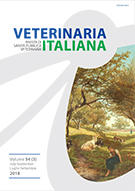Abstract
Canine leishmaniasis (CanL) is a systemic zoonotic disease caused by the protozoan Leishmania, an intracellular macrophage parasite, transmitted by the bite of phlebotomine sandflies. In dogs, the clinical disease is mostly characterised by symptoms associated with viscerocutaneous lesions such as lymphadenopathy, splenomegaly, skin lesions, and renal and ocular disease caused by the deposition of immune complexes. The parasite may provoke mucosal lesions which cause atypical clinical signs. The aim of this study is to describe an atypical nostril mass in a dog infected by Leishmania. Clinical examination did not show any systemic clinical signs, while haematological, biochemical, and urinary parameters demonstrated a mild disease stage. Diagnosis was confirmed through the isolation of cultured live parasites by biopsy. The dog was treated with a combination of miltefosine and allopurinol, showing full remission of clinical symptoms after 2 months. The authors outline the importance of considering CanL in the differential diagnosis of mucous and tumour-like lesions.

